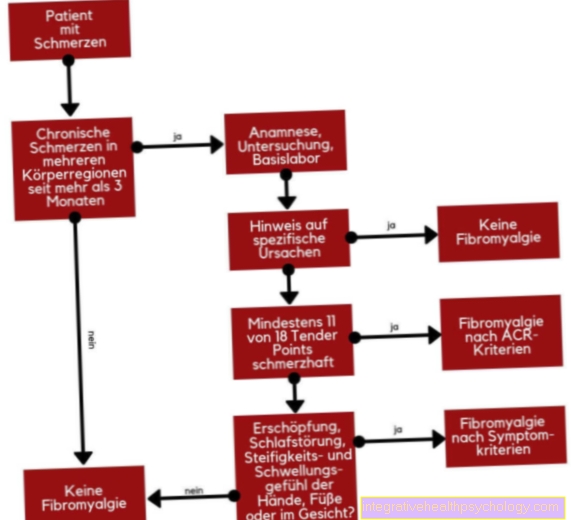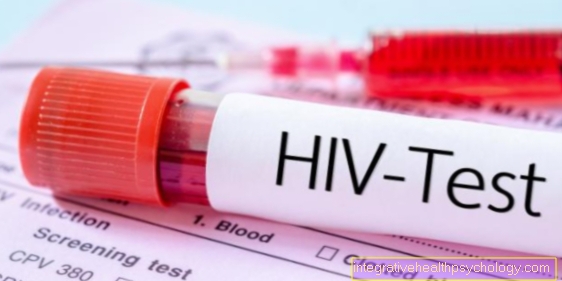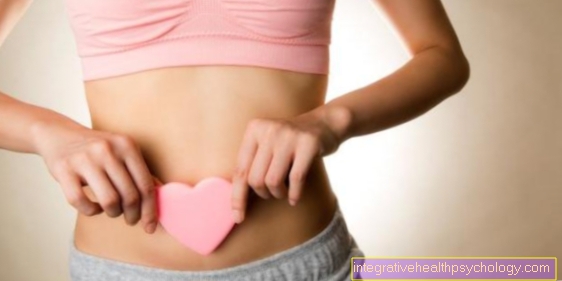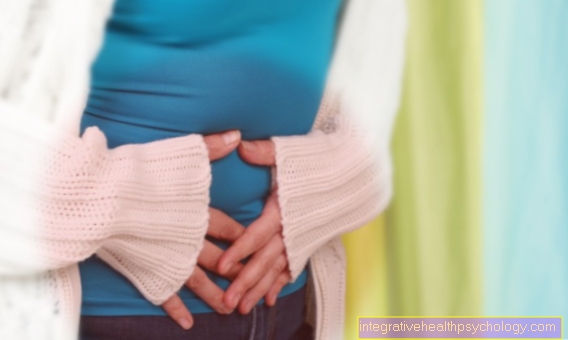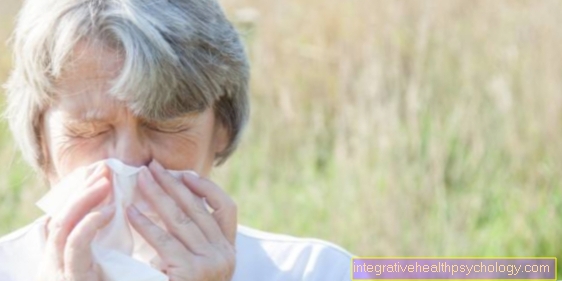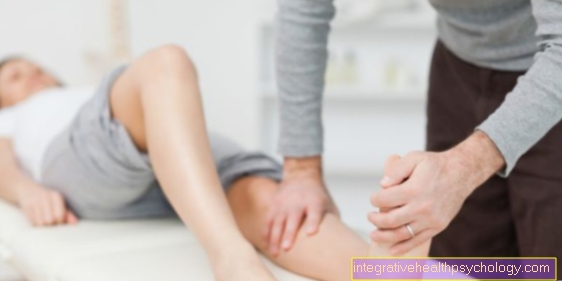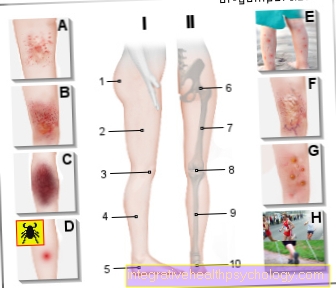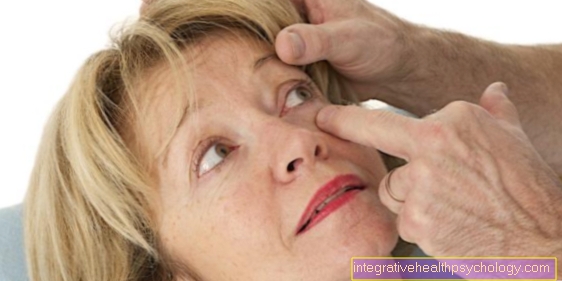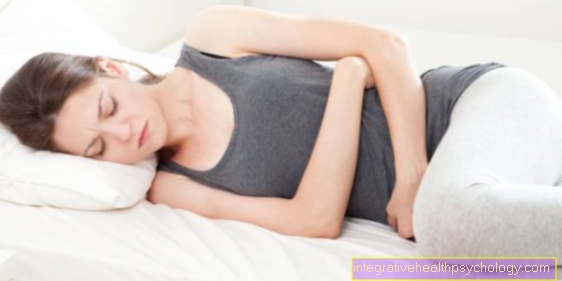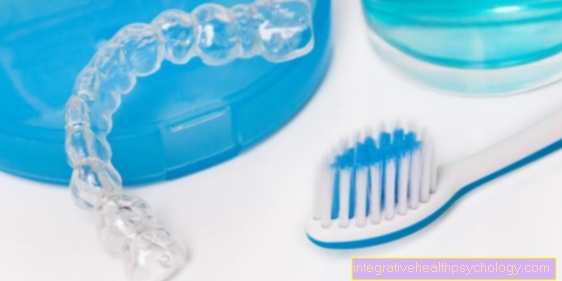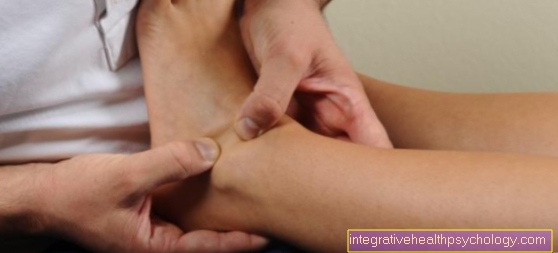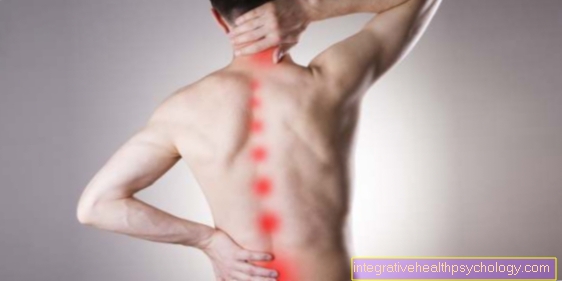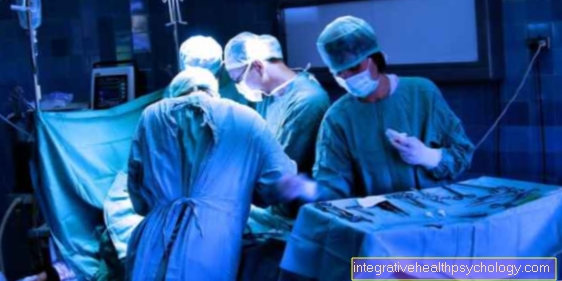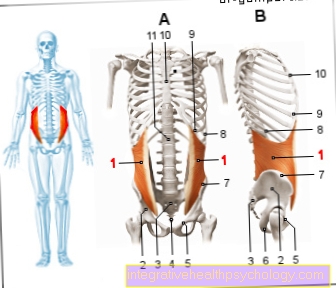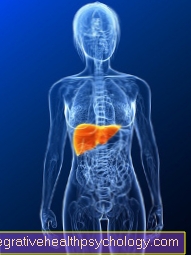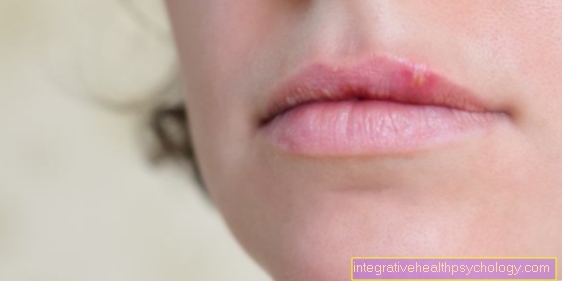Pulling in the hollow of the knee - is that dangerous?
introduction
Pulling in the hollow of the knee can be very uncomfortable, especially if it lasts for a long time.
The hollow of the knee is a complex anatomical region as it contains a multitude of tendons, vessels, nerves and muscles. Depending on the situation in which pulling occurs in the hollow of the knee, the causes and corresponding therapies can differ.
In principle, however, regardless of age and trigger, all of the diseases discussed below can always be responsible for the pulling.
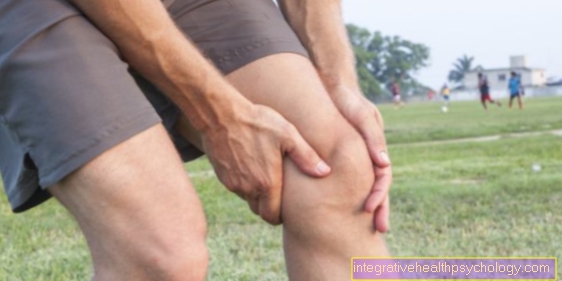
causes
There are several causes of pulling and pain in the back of the knee.
The location and duration of the pain play just as much a role as the athletic background and behavior before the pain occurred. Various acute and chronic clinical pictures that come into question are:
- Insufficient stretching of the muscles,
- Tendon irritation of the tendons of the calf muscles,
- Bruises and strains of the knee joint,
- Osteoarthritis of the knee,
- Rupture of the collateral or collateral ligament,
- Meniscus tear,
- Baker's cyst,
- swollen legs (leg edema) or
- a deep vein thrombosis.
The so-called Baker's cyst is specific to the hollow of the knee. This is a protuberance from the joint capsule. This is caused by increased fluid accumulation in the joint, for example through overload.
Pulling in the hollow of the knee can also occur in all types of knee joint injuries: contusions and sprains from falls are a common cause.
Serious injuries to the menisci, collateral ligaments and / or cruciate ligaments can also be the cause.
The knee joint swells as a result of the injury, which causes pulling in the hollow of the knee when stretching.
Another cause could be shortened and insufficiently strong muscles on the hollow of the knee.
The popliteal muscle itself, the so-called popliteus muscle, is rather insignificant. Often it is the joints and points of attachment of the hamstrings (back of the thighs) or the calf muscles that are irritated.
Pinching or irritation of nerves can also cause pulling in the hollow of the knee.
With sciatica (pain of the sciatic nerve) there is usually additional shooting pain. General overloading of the knee joint can also trigger pulling in the hollow of the knee.
As well as arthritis or osteoarthritis of the knee, both of which are chronic joint diseases.
In children, pulling in the hollow of the knee can also be caused by growth. You can find more information on this topic at: Growing pains in the knee.
The Baker's cyst
Baker's cyst is a common phenomenon of the hollow of the knee and is usually the result of another disease of the knee joint. The Baker's cyst is a fluid-filled space, a cyst, which was named after the English surgeon William Baker.
If the knee joint is damaged or inflamed, the body reacts with increased production of synovial fluid (Synovia). This means that the pressure inside the knee joint increases and at some point becomes too high, so that the joint capsule protrudes at a weak point. In the knee, this weak point is in the back wall of the knee joint capsule. As a result, a cyst develops in the hollow of the knee.
Small Baker's cysts are often asymptomatic and just an incidental finding. The larger the Baker's cyst, the more likely it is that complaints are caused by the mass. A Baker's cyst can appear as a palpable, visible swelling in the hollow of the knee. Typically, you can feel the movement of the fluid within the cyst, which is known as fluctuation. The Baker's cyst can put pressure on the surrounding tissue and cause pain and pulling in the hollow of the knee and upper calf.
In severe cases, circulatory disorders and nerve entrapment can occur.
Possible symptoms are
- Numbness,
- Tingling and
- Paralysis of the lower leg and foot.
For more information, see Baker's cyst.
Can the pulling in the back of the knee be a sign of multiple sclerosis?
A multiple sclerosis, MS for short, can take different courses and start with different symptoms. In addition to visual disturbances, severe fatigue and unsteady gait, the first frequent complaints are also unpleasant sensory disturbances in the legs. Although MS patients may experience pulling in the hollow of the knee at the onset of the disease or during an attack, along with other symptoms, an isolated pulling in the hollow of the knee does not support a diagnosis of multiple sclerosis.
For more information, see Multiple Sclerosis Diagnosis
Appointment with a knee specialist?
I would be happy to advise you!
Who am I?
My name is dr. Nicolas Gumpert. I am a specialist in orthopedics and the founder of .
Various television programs and print media report regularly about my work. On HR television you can see me every 6 weeks live on "Hallo Hessen".
But now enough is indicated ;-)
The knee joint is one of the joints with the greatest stress.
Therefore, the treatment of the knee joint (e.g. meniscus tear, cartilage damage, cruciate ligament damage, runner's knee, etc.) requires a lot of experience.
I treat a wide variety of knee diseases in a conservative way.
The aim of any treatment is treatment without surgery.
Which therapy achieves the best results in the long term can only be determined after looking at all of the information (Examination, X-ray, ultrasound, MRI, etc.) be assessed.
You can find me in:
- Lumedis - your orthopedic surgeon
Kaiserstrasse 14
60311 Frankfurt am Main
Directly to the online appointment arrangement
Unfortunately, it is currently only possible to make an appointment with private health insurers. I hope for your understanding!
Further information about myself can be found at Dr. Nicolas Gumpert
Strained calf
A calf strain occurs when the calf muscles are abruptly stretched beyond their natural extent. The calf, along with the thigh muscles, is one of the muscles that are most commonly affected by such sports injuries.
A strained calf is typically associated with muscle hardening and cramp-like symptoms. A feeling of tension and a pulling in the muscle are typical accompanying complaints. It can pull down to the hollow of the knee.
For details, see Strained calf.
Pain in the back of the knee
A simultaneous occurrence of pulling and pain in the hollow of the knee can indicate various injuries and illnesses.
Possible causes are
- Damage to the ligaments and menisci in the knee,
- an overload in sports,
- a Baker cyst
- and less often a thrombosis of the leg veins.
Occasionally, nerve irritation of the shinbone nerve, tibial nerve, or growing pains in the child can cause the symptoms.
Epiphysolysis can very rarely be the cause of the symptoms. This is a detachment of the growth plate on the bone. If there is pulling and pain in the hollow of the knee, you should see a doctor and have the affected knee examined.
swelling
A pulling in the hollow of the knee and swelling in this area may be an indication
- Baker's cyst,
- Joint inflammation
- or leg vein thrombosis. Injury to the structures in the joint, for example through intense exercise during exercise, can cause signs of inflammation and a feeling of tension. If the tissue is not only swollen but also reddened, heated and tender on pressure, this indicates an inflammation in the affected knee.
Pulling in the hollow of the knee after twisting the knee
A knee twist causes a twist or twist in the knee joint. This means that the normal range of motion of the knee joint is exceeded in the accident and the knee joint is briefly levered out of its position.
Twisting the knee causes severe pain. Typically, there is also significant swelling, a bruise and restricted movement of the knee joint. In addition to pain, those affected may experience an uncomfortable feeling of tension and pulling in the hollow of the knee.
Concomitant symptoms
Tearing in the hollow of the knee is often associated with knee injuries and is due to the swelling of the joint.
Accompanying symptoms are knee pain, which occurs especially during exercise.
Overheating of the knee and limited mobility are also noticeable.
Mobility can be limited in both flexion and extension. However, pulling in the hollow of the knee typically occurs primarily while stretching.
If ligament structures in the knee are injured, the joint often feels unstable, so that a normal appearance (also due to pain) is not possible. Instead, the affected people hobble, sometimes crutches are necessary as an aid.
Tension pain can also occur in the knee joint and especially in the hollow of the knee.
This is particularly noticeable in the case of Baker's cyst.
If nerve damage is the cause of pulling in the hollow of the knee, it can also lead to a loss of strength and sensory disturbances.
The pulling cannot be limited to the hollow of the knee.
If the cause is shortened muscles, the feeling usually extends over the entire course of the affected muscles. This usually affects either the calf or the back of the thigh.
Pulling in the hollow of the knee when running
Pulling while moving generally indicates mechanical damage to the musculoskeletal system.
While pain, which is also present at rest, tends to suggest a more dangerous occurrence, in the case of pain when moving, one can be relatively sure that the movement is the trigger for the pain or the pulling.
It is also important whether the pain only occurs while running or already while walking. We use the same muscles and the same joints in both processes, but running puts a much greater strain on the musculoskeletal system than walking. So pulling while walking tends to indicate more severe damage than pulling while running.
It is also helpful if the pulling can be localized more precisely within the hollow of the knee. Pulling in the lower part of the hollow of the knee - i.e. in the direction of the calf - is more indicative of tendon irritation or tendon strain of the triceps surae muscle. The triceps surae has three (“tri-”) muscle heads, all of which have their origin in the hollow of the knee. The triceps surae is also commonly known as the "calf muscles".
Where a muscle is attached to a bone, there are tendons that fix the muscle body to the bone. These tendons can be irritated - for example from intensive running training - and cause pulling. This is rather harmless and should disappear again with gentle exercise or not occur at all with gentle training.
Read more about this at:
- Pain in the calf and the hollow of the knee.
In the worst case, pulling is more of a pain than pulling, depending on how much the tendons have been overstretched. Incidentally, we can very easily reproduce this kind of pain or pulling in the hollow of the knee if we straighten our knees and try to touch the ground with the tips of our hands. However, you should not do this if the back of your knee is already painful, as it would relatively certainly increase the pain and pulling.
Please also read the article:
- Pain in the hollow of the knee - this is the cause.
If the pulling was noticeable quite suddenly while walking - i.e. there are no signs of a chronic occurrence - it may be a strain or bruise.
Bruises would be more likely in the area of the kneecap, but they can sometimes reach the hollow of the knee.
The leg is usually fully extended just before the step.
If there is a stretch deficit in the knee joint due to shortened muscles, this can trigger pulling in the hollow of the knee with every step. The reason for this can lie in both the calf muscles and the muscles of the back of the thighs.
Targeted stretching helps against this.
Much less often, pulling in the hollow of the knee when walking is triggered by leg edema.
This is water retention in the legs.
The cause can be venous insufficiency. The veins are not able to move the blood, which is pumped into the legs, back up against gravity.
Heart diseases that weaken the heart muscle also lead to water retention in the legs.
Another cause can be kidney weakness, as it means that not enough fluid can be excreted.
Such edema stretches the skin in the legs, which can also cause pulling in the hollow of the knee.
A rare but dangerous disease that such pulling in the hollow of the knee can trigger is leg vein thrombosis.
This is a blood clot that is stuck in a vein. This causes the blood to build up in the legs, which can cause the hollow of the knee to pull. The danger of the clot is that it can loosen and cause a life-threatening embolism in the lungs.
Pulling in the hollow of the knee after exercise
Pulling in the hollow of the knee after exercising and especially after running can, in the best case, be a sign of insufficient stretching before exercise. It's not for nothing that stretching and loosening should be part of every recommended warm-up program. Pulling that is only caused by insufficient stretching is not dangerous and usually disappears after a few days. Make sure you stretch enough before and after exercising.
Pulling in the hollow of the knee after exercise also indicates that the knee joint is overloaded.
This can occur when, for example, unfamiliar sports and movements are performed. In this case, the body and muscles have to adapt to the new load.
Before this, sore muscles in the calf muscles or the muscles at the back of the thigh can also be the cause of the pulling in the hollow of the knee.
Sudden heavy strain on these muscles can lead to a strain that can cause pain in the muscles and pulling in the area as well. In this case, a break from exercising is strongly recommended.
Exercising too much can also provoke an irritated Baker's cyst, which causes discomfort in the hollow of the knee.
If this is not the case, more serious causes must be considered. Pulling while walking in particular also suggests damage that can be triggered by even very little stress. Depending on the age, wear processes in the knee joint itself should also be considered, i.e. osteoarthritis.
Long-term, high stress on the knee joint can lead to abrasion of the cartilage surfaces and wear and tear on the joint surfaces. This particularly affects competitive athletes, such as marathon runners or soccer players, but also overweight people who put a lot of weight on their joints.
However, with age, amateur athletes can also be affected.
Pain and pulling in the hollow of the knee while running can herald this.
These symptoms can occur prematurely, especially in sports that “get on the joints” such as tennis, squash, jogging, and football games.
Whether it is actually osteoarthritis can easily be clarified with an X-ray, a CT or an MRI of the knee. In daily practice, the CT plays a subordinate role.
An experienced doctor can easily determine the stage of osteoarthritis in the x-ray of the knee. The only way to accurately visualize the cartilage damage is with an MRI of the knee.
Read more about the MRI of the knee joint.
In this case, more joint-friendly sports such as swimming, cycling or yoga should be preferred.
While pulling in the hollow of the knee after exercise, as already mentioned, can be the first harbingers of an impending deterioration, pain while walking should already be viewed as an advanced stage. If the pain or pulling has existed for a long time and has "crept in" latently, a chronic process such as progressive osteoarthritis should be considered.
Sports injuries, which may not have been noticed at first in the heat of the moment, also need to be considered, especially after exercising.
It is only when you get home that it starts to pull and hurt. In this case, however, relief and cooling can usually be relieved of symptoms within a few days.
If there was a collision or a twisting of the knee while exercising, one must also think about an injury to internal structures. A simple bruise can cause the knee joint to swell, which not only causes pulling in the hollow of the knee, but also a lack of extension and flexion and pain in the knee. More severe ligament or meniscus injuries usually result in a long break in sports, and surgery is often necessary.
If the pulling in the hollow of the knee is clearly due to an acute cause, pain relievers such as Ibuprofen or - if you have a sensitive stomach - better Paracetamol be taken.
If the pulling persists for more than three days and does not get noticeably better during this time, a visit to the family doctor or orthopedic surgeon is recommended.
The same applies to complaints that have existed for a long time - months - and have now worsened. Imaging procedures are available to the doctor with which he can assess the "inner workings" of the knee, which is absolutely necessary in the case of chronic diseases.
Pulling in the hollow of the knee often disappears on its own relatively quickly and is not considered to be dangerous.
However, if it persists for a long time or develops slowly, research should be carried out into the causes in order to rule out a more dangerous occurrence.
Pulling in the hollow of the knee down to the calf - is that a thrombosis?
A pulling in the hollow of the knee, which reaches into the calf, suggests a muscular cause.
The calf muscles - more precisely the trcieps surae muscle - consists of two large muscles:
On the one hand the gastrocnemius muscle, which with its thick muscle belly forms the outer part of the calf muscles that is visible from the outside. Its two muscle heads have their origin on the thigh bone and thus run from the hollow of the knee to the Achilles heel.
The soleus muscle is located below the gastrocnemius muscle. It also has its origin in the hollow of the knee, more precisely on the back of the tibia and fibula. Both muscles together form the triceps surae muscle.
Read more about this at:
- Pain in the calf and the hollow of the knee.
We need this muscle on the one hand when we want to bend our knee and on the other hand when we stand on our toes.
This muscle is almost always exposed to a lot of stress, especially during sport. Pulling from the hollow of the knee to the calf usually affects this muscle, and this is particularly common after exercise.
As already mentioned, the pulling can be caused by a stretched ligament or a torn ligament in the hollow of the knee. Pulling into the calf would not necessarily be typical for this.
In addition to the tendon, the muscle can also be overstretched, and individual muscle fibers can even be torn. Pulling up to the calf would be quite conceivable in such a scenario. After a few days of rest, the pulling and the pain usually go away on their own - provided the muscle is sufficiently spared during this time.
Read more on the topic:
- Pulling in the calf.
However, if there is no reason for a muscle overstretching, a more serious cause must also be considered:
For example, if you feel pain and pulling in your calf after long periods of sitting, such as long bus rides or long flights, this can be a sign of a thrombosis.
This can also occur in younger patients, for example when taking the “pill” (see: Thrombosis risk of the pill), or with overweight nutritional status.
In such cases, a doctor should be consulted as soon as possible, as the thrombosis can dissolve and reach the lungs or brain as an embolus.
There it can trigger a pulmonary embolism or a stroke.
A simple ultrasound examination of the calf can rule out or confirm the suspicion of a thrombosis.
A thrombosis is a blood clot within a blood vessel. This can either close the vessel directly on the spot, or loosen and get to other parts of the body. There the blood clot can continue to grow and thus also block larger - and more important - vessels, such as the brain arteries.
The legs are predestined for thrombosis. One then speaks of leg vein thrombosis or calf vein thrombosis. A thrombosis usually manifests itself as painful blood congestion, overheating and swelling of the leg in the area behind the thrombosis.
But pulling in the hollow of the knee can also be characteristic, at least in the initial stages.
Are risk factors for leg vein thrombosis
- the pill",
- Overweight,
- Smoke,
- little movement,
- and dehydration.
Therefore, especially on flights, you should always drink enough and continuously.
On long-haul flights, it is also advisable to go up and down in the aircraft: When you move, the contracting leg muscles massage the vessels and thus promote the flow of blood within the veins.
But thrombosis stockings can also help: These are particularly narrow and thus compress the veins running on the surface, which increases the speed of blood flow.
The deeper arteries are not affected by the increased pressure.
Not sure if your knee pain is indicative of a thrombosis? Read on under:
- How can you recognize a thrombosis?
Pulling in the hollow of the knee when stretching or bending
Pulling in the hollow of the knee occurs in particular during movements that use the knee to its full extent.
This includes the complete stretching and complete bending of the knee joint. When stretching the knee, the two muscle heads of the calf muscle "Musculus gastrocnemius" are stretched to their full length, as the muscle is attached to the thigh on the one hand and the heel on the other. If the muscles or the tendons on the heel and thigh are already irritated, this can cause additional pain.
An uncomfortable pulling occurs in the hollow of the knee and Achilles tendon.
When stretching while warming up, this is completely normal and, up to a certain point, intentional.
After all, the muscles should be stretched.
However, the stretch should not be longer than seven seconds at a time and only to a tolerable degree of pain.
If the pulling is already at rest, then under no circumstances should it be stretched and the leg should be allowed to rest.
Exercise should then generally be avoided until pulling no longer occurs.
However, when the leg is bent, the structures in the hollow of the knee are compressed and put under pressure. If the space in the hollow of the knee is already restricted, this can cause pain.
A prominent representative of masses in the hollow of the knee is the so-called Baker's cyst. It is an outward protuberance of the joint capsule of the knee joint towards the dorsal side (i.e. “back”) into the hollow of the knee. As a result, the muscles located there are narrowed and the nerves and vessels of the hollow of the knee are compressed, which in turn causes pain.
Particularly when the leg is bent, the already cramped conditions in the hollow of the knee are further worsened, as the relaxed calf muscles push upwards and skin and fat tissue press into the hollow of the knee.
A Baker's cyst can easily be felt from the outside as a small protrusion in the hollow of the knee.
The diagnosis is made using MRI of the knee joint or ultrasound.
Baker's cyst is just one of the reasons why bending the knee in the hollow of the knee can cause pain and pulling.
Malformations of the vessels, swelling from bruises and excessive fatty tissue can also compress nerves in the hollow of the knee and cause pain.
Pulling on the outside of the knee
Pulling on the outside of the hollow of the knee can indicate a rupture of a collateral ligament (also known as collateral ligament).
These bridge the knee joint and form a connection between the lower leg and thigh. Your task is to stabilize the knee to the side.
If the knee joint is kicked from the side, the collateral ligament may tear - usually on the side opposite the kick. A kick from the outside on the outside of the left knee would result in a tear in the inner collateral ligament of the left knee.
A rupture of a collateral ligament is less serious than a cruciate ligament rupture because it usually does not require an operation.
However, it also requires an immobilization and healing phase lasting several weeks, which can be up to 20 weeks.
Read more about this at:
- External ligament tear on the knee.
A meniscus tear must also be considered.
The menisci lie in pairs on the right and left in the knee joint in the joint spaces.
They “buffer” the pressure that the part of the body above the calf exerts on it. '
A meniscus tear can cause pain and uncomfortable pulling in the hollow of the knee. The pulling can be heard above all in the outer area of the knee joint, and can be more pronounced when walking and under strain. A meniscus tear can also be treated conservatively, i.e. without surgery.
It is currently controversial whether an operation actually brings advantages. With an operation there is always the risk of introducing germs into the sterile joint capsule - the knee is particularly susceptible to this.
Whether an operation has to be performed depends on many factors such as general condition, physical activity and age.
Incidentally, statistically speaking, the inner meniscus is affected twice as often as the outer meniscus.
Find out more about this:
- Meniscal surgery.
After sitting / when getting up
One of the most dangerous complications that can cause back knee pain and pulling is leg vein thrombosis. It occurs especially after long periods of sitting on a plane or bus.
Often when you get up you notice a real sting in the legs and a tingling sensation and pulling over the calves, which reach into the hollow of the knee. The legs are heavy and swollen.
Read more on the topic:
- Swollen hollow of the knee
This is normal after long periods of sitting, as water and blood - following gravity - collect in the legs.
While walking, the muscles massage the vessels and pump the blood out of the legs back towards the heart - this is the reason why we do not have fat legs after long marches.
On the plane, however, we are restricted in our freedom of movement, which is why our legs become fat. In the worst case, small blood clots form in the deep leg veins due to the slowed blood flow, which grow over time and clog our veins. Pain after long periods of sitting - i.e. over 3-4 hours at a time - can indicate a thrombosis, depending on the circumstances.
Sometimes we can also observe this phenomenon when we get out of bed. If the legs are swollen and pulled up to the hollow of the knees, this is often a sign of impaired cardiac output.
The famous “water in the legs” is a sign that the heart is no longer able to transport the entire volume of blood when it is at rest - that is, during sleep.
At this point at the latest, you should visit your family doctor or cardiologist.
Find out more about this topic:
- Swollen legs.
Pulling in the hollow of the knee after cruciate ligament surgery
Cruciate ligament surgery is a major intervention in the knee joint. Then the knee is irritated, and the cruciate ligament injury also causes swelling of the knee.
This leads to movement restrictions in both flexion and extension.
Especially when stretching, this swelling is usually accompanied by pulling in the hollow of the knee.
The symptoms usually go away when the joint is swollen.
However, this can take several weeks.
The swelling and pulling in the hollow of the knee may reappear when the joint is subjected to the first real sporting loads.
Please also read the article:
- Pain after knee surgery
diagnosis
The diagnosis of pulling in the hollow of the knee initially consists of a specific anamnesis (patient survey by the doctor).
The cause and type of complaint should be found in a conversation with the person concerned.
It is always important how long the symptoms have existed, whether they have occurred before, how strong the symptoms are and whether there are triggers for them.
Typical triggers would be:
- Accidents,
- Collisions,
- Injuries or also
- unusual strain on the knee.
Then the affected knee joint is examined.
Some abnormalities, such as swellings and external injuries, can catch the eye with the naked eye.
The tenderness on pressure in the hollow of the knee and other structures on the knee is also examined.
Then the range of motion in flexion and extension is tested.
There are also specific function tests that can provide information on meniscus damage, ligament injuries or nerve lesions.
In order to be able to make a final diagnosis, imaging is usually also required.
To do this, the X-ray image is used to assess bone damage. Osteoarthritis of the knee, for example, can be noticed.
However, the soft tissue structures in the knee joint are usually the cause of pulling in the hollow of the knee.
These can be assessed particularly well in MRT imaging. There, ligament and meniscus injuries as well as a Baker cyst can be noticed.
Do you want to know what to expect from an MRI? Read the article:
- Procedure of an MRI.
therapy
Knee joint discomfort, such as a pulling in the hollow of the knee, is treated depending on the cause of the symptoms.
A Baker's cyst does not always have to be treated, but the underlying disease should be treated. An indication for treatment of a Baker's cyst is when the cyst causes discomfort. Then medical, minimally invasive and surgical methods are used.
In the case of injuries to the knee joint, such as meniscus damage or ligament injuries, conservative and surgical treatment options come into question, depending on the individual situation. Both knee twisting and muscle strain, such as a calf strain, are treated conservatively, typically using the PECH regimen. The PECH scheme stands for break, ice, compression and elevation of the affected leg.
A deep vein thrombosis is usually treated with blood-thinning medication and appropriate positioning, compression therapy. Drug thrombolysis or surgery to remove the clot (thrombus) are weighed individually.
Warm or cool?
Cooling helps with acute knee injuries, for example
- Knee twist,
- Muscle strain,
- Sports injuries to the joint that injure ligaments or the menisci
- as well as inflammation.
By exposure to cold, messenger substances that cause the symptoms of inflammation are inhibited. In the case of acute injuries, the cold also helps to keep the swelling in check. At the same time, hematomas typically turn out smaller if the tissue is regularly cooled.
In addition, heat can also be useful, but more likely for chronic illnesses. If you have chronic knee disease, like arthrosis, or chronic knee inflammation, heat therapy can have positive effects on the healing process. Fango applications are very suitable for use on the affected knee. Warmth promotes blood circulation and promotes the removal of metabolic waste products.
Can a knee brace help?
A knee brace is used to stabilize the knee in one position and to relieve it.
In a condition following ligament injuries or meniscus damage, a bandage can help relieve stress on the knee so it can heal. At the same time, there are knee braces that have anatomical pads around the kneecap, which are supposed to relieve pain.
Knee supports can be indicated for various diseases of the knee joint. Whether there is an indication should be discussed with the attending physician.

